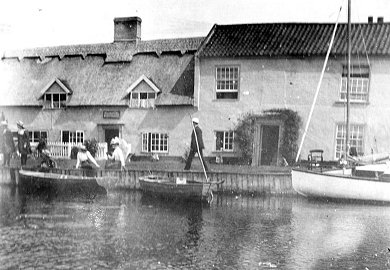
| NORFOLK | NORWICH | GT. YARMOUTH | KINGS LYNN | NAME SEARCH | PUBLICATIONS | LINKS | MYSTERY | HOME |
| NORFOLK PUBLIC HOUSES |
 |
|||||||||
|
||||||||||
|
||||||||||||||||||||||||||||||||||||||||||||||||||||||||||||||||||||||||||||||||||||
|
 c1910 Site of a Mead House established by St. Benets monks c1040. A Mrs Grabbard is thought to have leased the house in 1500 at an annual rent of 7 shillings plus two fat hens. Lot No. 17 in sale by auction of the Coltishall Brewery estate 21st May 1796. ``With a yard and the barn, stables and outhouses thereto belonging; Also about 3 Acres 2 Roods by estimation of arable land and about 9 acres by estimation of marsh land with a reed rond * ; Also a commodious Ferry Boat built a few years since at the expense of £100 and upwards; Together with Tolls arising from the ferry. Leasehold of the Bishop of Norwich for three lives viz, of William Baker Esq., aged about 80 years, Susanna Ransome aged about 41 years and the said Chapman Ives aged about 38 years. Lease rent 8 shillings per annum.'' Leasehold premises, owned by the Lord Bishop of Norwich for three lives, as advertised for sale 4th November 1797. Including Yard, Barn, Stables, Outhouses and about 4 acres of arable land and 9 acres of marsh land.
Lot No. 7 in a Sale by Auction Saturday 30th January 1819. One end of original house was rebuilt and carried the date 1825. The thatched house was destroyed by bombing at 9.45pm 26th April 1941. Subsequent
reports stated that 21 of the 24 occupants were killed. A later account gives the number
of dead as 22. Licensee Albert Stringer was `pulled alive from the wreckage by his wife
Rita'.
The TFI RESTAURANT by mid 2017. |
|||||||||||||||||||||||||||||||||||||||||||||||||||||||||||||||||||||||||||||||||||
* Reed Rond = Dredged material deposited against river bank to allow reed growth and habitat for wildlife and fish.
See pages 19 and 22 in The Norfolk Broads In Old Postcards, first published 1990.
|
|
Memories collected by Chris Holderness of
Rig-a-Jig-Jig for the East Anglian Traditional Musical Trust. The CH numbers refer to Chris's Archive on eatmt.org. |
||
|
From Broadland Sport by Nicholas Everitt, 1902 (CH B11-1-1b) Visiting first the low-roofed kitchen, we watched for upwards of half an hour the many and varied step dances of the Horning rustics. An American hand organ* provided the music and a liberal supply of nutty brown ale, with a dash of gin in it, promoted the energy of the dancers to an extent amazing to onlookers.' *If he is referring to a barrel organ, or a harmonium, they are most unsuitable for accompanying step dancing. It was more likely to have been a melodeon, which Mr Everitt had probably never seen before. AH
|
|||